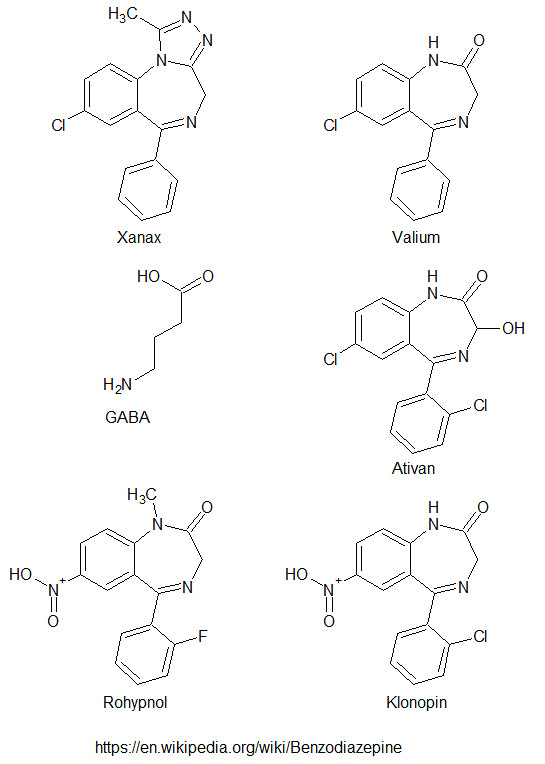Valium launched in 1963. Ativan opened for US sales in 1977. Klonopin opened for US sales in 1975. Rohypnol launched in 1974, but was never marketed in the US. Xanax launched in 1981.
In the mid-1950s, chemists at Hoffman-LaRoche intended to discover new tranquilizers. Valium was among the first pharmacological and commercial successes. By 1980s, it was known that this class of molecules resulted in chemical dependence (addiction). However, use of these compounds for short-term relief from anxiety have not significantly dropped. Dependence and tolerance, coupled with dosage escalation and withdrawal symptoms, may appear after as little as 3 weeks.
 |
Benzodiazepines work by binding to the GABAA receptor, at a site adjacent to the binding sites for GABA. The native ligand, GABA, inhibits nerve action by flooding the cell with chloride ions so that the nerve cannot "fire." Binding of benzodiazepines opens the ion channel even more, letting in more chloride ions, assisting in hyperpolarization, shutting the neuron "off." This is why benzodiazepines have the effect of a general nervous system depressant, muscle relaxant, and interfere with the formation of memories.
Treatment of insomnia can be achieved using benzodiazepines, however there are significant adverse-effects. Benzodiazepines are controlled substances and can lead to cognitive impairment, falls/fractures, delirium/dementia, anterograde amnesia, altered sleep activities (e.g., sleep-eating, sleepdriving, sleep-walking), and carryover sedation. Lack of memory formation is a contributing factor for Rohypnol's use as a date rape drug.
Long term use can result in permanent changes in the quantity of GABAA receptors and/or the configuration of GABAA receptors. This may be why rebound anxiety or rebound insomnia is a common withdrawal symptom. Overdose is possible, resulting in death by cessation of breathing. Benzodiazepines may cause or worsen depression. Upon cessation, seizures similar to delirium tremens are observed.
Treatment of insomnia can be achieved using benzodiazepines, however there are significant adverse-effects. Benzodiazepines are controlled substances and can lead to cognitive impairment, falls/fractures, delirium/dementia, anterograde amnesia, altered sleep activities (e.g., sleep-eating, sleepdriving, sleep-walking), and carryover sedation. Lack of memory formation is a contributing factor for Rohypnol's use as a date rape drug.
Long term use can result in permanent changes in the quantity of GABAA receptors and/or the configuration of GABAA receptors. This may be why rebound anxiety or rebound insomnia is a common withdrawal symptom. Overdose is possible, resulting in death by cessation of breathing. Benzodiazepines may cause or worsen depression. Upon cessation, seizures similar to delirium tremens are observed.
This class of drugs is still in use to alleviate pre-surgical nervousness, as they are fast-acting and potent. All are available as generic versions, but all require a prescription.
References
Wietholter, J. P. and Coetzee, R. "FDA-Approved Nonbenzodiazepine Receptor Agonists for the Management of Insomnia." US Pharm. 2017;42(1):29-32.
References
Wietholter, J. P. and Coetzee, R. "FDA-Approved Nonbenzodiazepine Receptor Agonists for the Management of Insomnia." US Pharm. 2017;42(1):29-32.

No comments:
Post a Comment